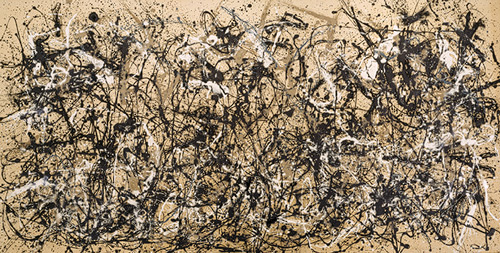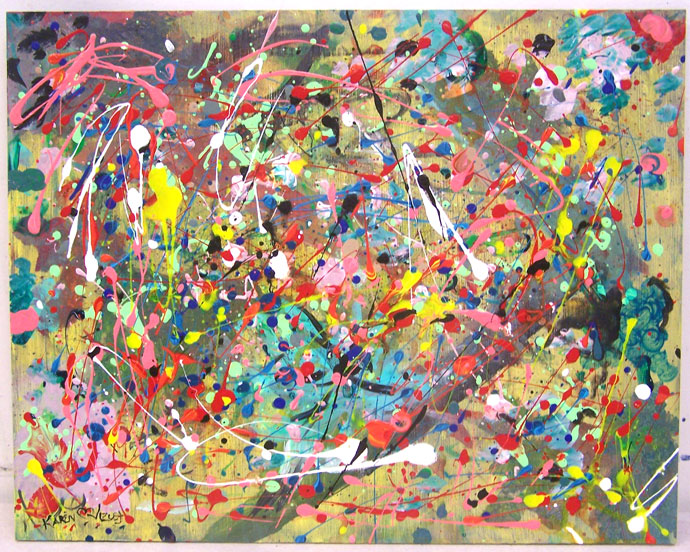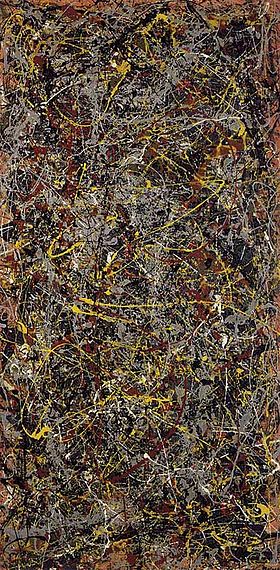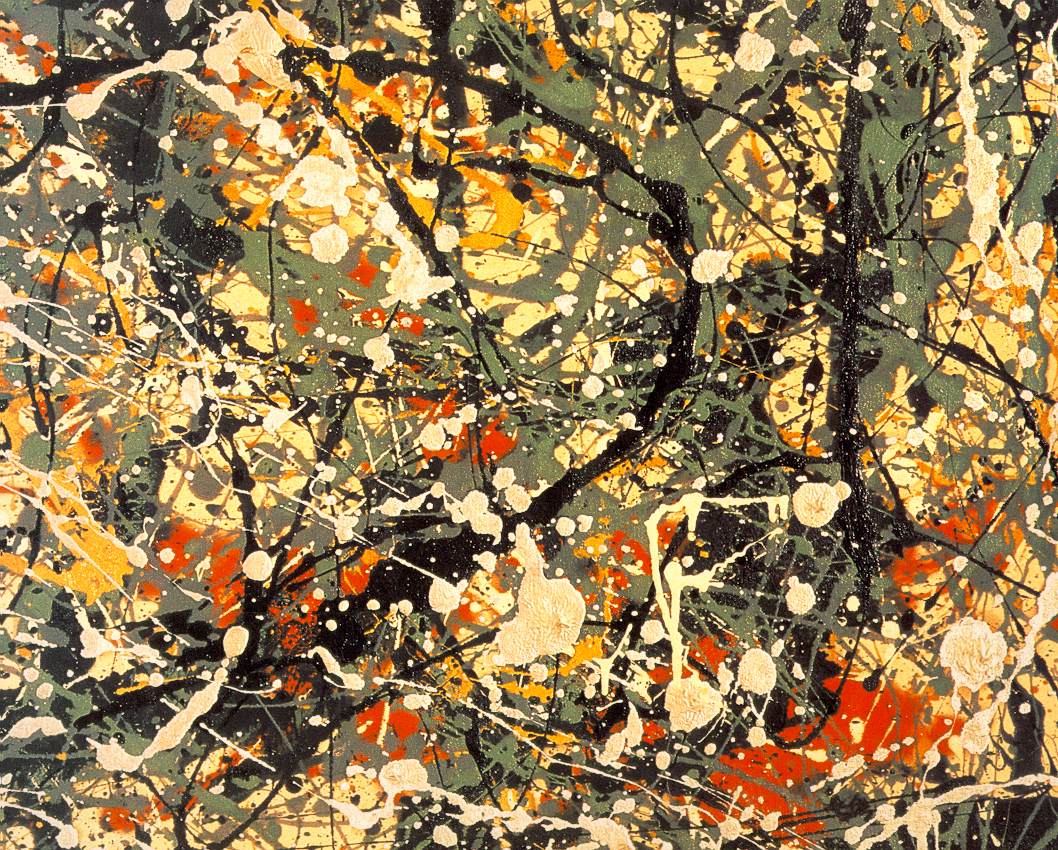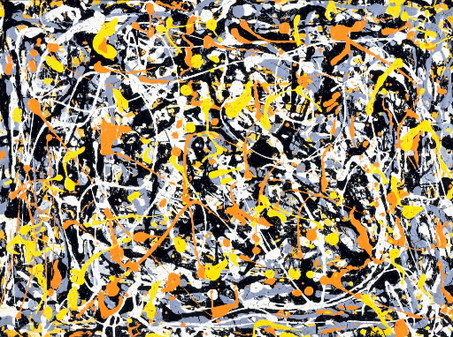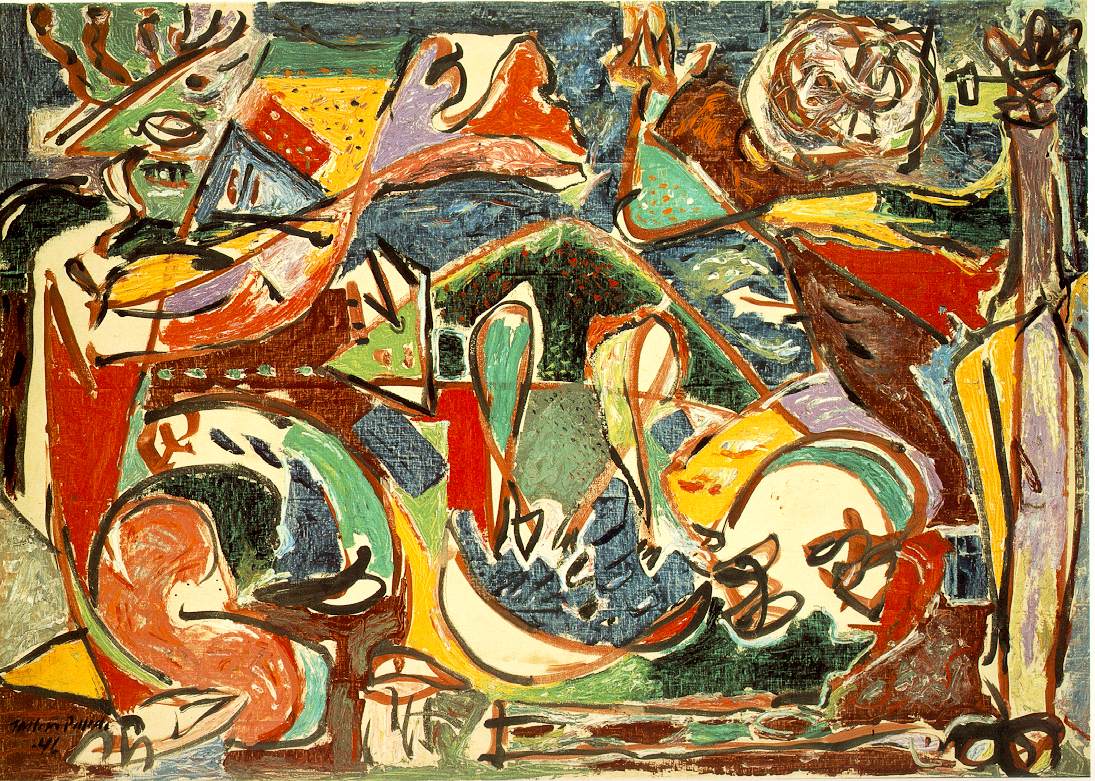<Back to Index>
- Painter Paul Jackson Pollock, 1912
PAGE SPONSOR
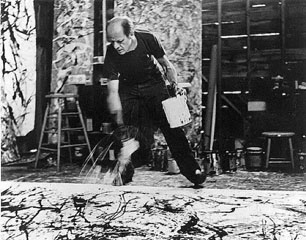
Paul Jackson Pollock (January 28, 1912 – August 11, 1956), known as Jackson Pollock, was an influential American painter and a major figure in the abstract expressionist movement. He was well known for his uniquely defined style of drip painting.
During his lifetime, Pollock enjoyed considerable fame and notoriety. He was regarded as a mostly reclusive artist. He had a volatile personality, and struggled with alcoholism for most of his life. In 1945, he married the artist Lee Krasner, who became an important influence on his career and on his legacy.
Pollock died at the age of 44 in an alcohol related car accident. In December 1956, the year of his death, he was given a memorial retrospective exhibition at the Museum of Modern Art (MoMA) in New York City, and a larger more comprehensive exhibition there in 1967. More recently, in 1998 and 1999, his work was honored with large scale retrospective exhibitions at MoMA and at The Tate in London.
In 2000, Pollock was the subject of an Academy Award
winning film Pollock directed by and starring Ed
Harris.
Pollock was born in Cody, Wyoming, in 1912, the youngest of five sons. His parents, Stella May (McClure) and LeRoy Pollock, grew up in Tingley, Iowa. His father had been born McCoy but took the surname of his neighbors, who adopted him after his own parents had died within a year of each other. Stella and LeRoy Pollock were Presbyterian; the former, of Irish descent; the latter, of Scotch - Irish descent. LeRoy Pollock was a farmer and later a land surveyor for the government. Jackson grew up in Arizona and Chico, California. While living in Echo Park, California, he enrolled at Los Angeles' Manual Arts High School, from which he was expelled, after having been expelled from another high school in 1928. During his early life, he experienced Native American culture while on surveying trips with his father. In 1930, following his brother Charles Pollock, he moved to New York City where they both studied under Thomas Hart Benton at the Art Students League of New York. Benton's rural American subject matter shaped Pollock's work only fleetingly, but his rhythmic use of paint and his fierce independence were more lasting influences. From 1938 to 1942, Pollock worked for the WPA Federal Art Project.
In attempts to fight his alcoholism, from 1938 through
1941 Pollock underwent Jungian
psychotherapy with Dr. Joseph Henderson and later
with Dr. Violet Staub de Laszlo in 1941 - 1942. Henderson
made the decision to engage him through his art and had
Pollock make drawings, which led to the appearance of many
Jungian concepts in his paintings. Recently it has
been hypothesized that Pollock might have had bipolar
disorder.
In October 1945, Pollock married American painter Lee Krasner, and in November they moved to what is now known as the Pollock - Krasner House and Studio, at 830 Springs Fireplace Road, in the Springs area of East Hampton, on Long Island, NY. Peggy Guggenheim lent them the down payment for the wood frame house with a nearby barn that Pollock converted into a studio. There he perfected the technique of working with paint with which he would become permanently identified.
Pollock was introduced to the use of liquid paint in 1936 at an experimental workshop operated in New York City by the Mexican muralist David Alfaro Siqueiros. He later used paint pouring as one of several techniques on canvases of the early 1940s, such as "Male and Female" and "Composition with Pouring I." After his move to Springs, he began painting with his canvases laid out on the studio floor, and he developed what was later called his "drip" technique, turning to synthetic resin based paints called alkyd enamels, which, at that time, was a novel medium. Pollock described this use of household paints, instead of artist’s paints, as "a natural growth out of a need." He used hardened brushes, sticks, and even basting syringes as paint applicators. Pollock's technique of pouring and dripping paint is thought to be one of the origins of the term action painting. With this technique, Pollock was able to achieve a more immediate means of creating art, the paint now literally flowing from his chosen tool onto the canvas. By defying the convention of painting on an upright surface, he added a new dimension by being able to view and apply paint to his canvases from all directions. One possible influence on Pollock was the work of the Ukrainian American artist Janet Sobel (1894 – 1968) (born Jennie Lechovsky). Sobel's work is related to the so-called "drip paintings" of Jackson Pollock. Peggy Guggenheim included Sobel's work in her The Art of This Century Gallery in 1945. The critic Clement Greenberg, with Jackson Pollock, saw Sobel's work there in 1946, and in his essay "American - Type' Painting" Greenberg cited those works as the first instance of all - over painting he had seen, stating that "Pollock admitted that these pictures had made an impression on him".
In the process of making paintings in this way, he moved away from figurative representation, and challenged the Western tradition of using easel and brush. He also moved away from the use of only the hand and wrist, since he used his whole body to paint. In 1956, Time magazine dubbed Pollock "Jack the Dripper" as a result of his unique painting style.
My painting does not come from the easel. I prefer to tack the unstretched canvas to the hard wall or the floor. I need the resistance of a hard surface. On the floor I am more at ease. I feel nearer, more part of the painting, since this way I can walk around it, work from the four sides and literally be in the painting.
I continue to get further away from the usual painter's tools such as easel, palette, brushes, etc. I prefer sticks, trowels, knives and dripping fluid paint or a heavy impasto with sand, broken glass or other foreign matter added.
When I am in my painting, I'm not aware of what I'm doing. It is only after a sort of 'get acquainted' period that I see what I have been about. I have no fear of making changes, destroying the image, etc., because the painting has a life of its own. I try to let it come through. It is only when I lose contact with the painting that the result is a mess. Otherwise there is pure harmony, an easy give and take, and the painting comes out well.
—Jackson Pollock, My Painting, 1956
Pollock observed Indian sandpainting demonstrations in the 1940s. Other influences on his dripping technique include the Mexican muralists and Surrealist automatism. Pollock denied "the accident"; he usually had an idea of how he wanted a particular piece to appear. His technique combined the movement of his body, over which he had control, the viscous flow of paint, the force of gravity and the absorption of paint into the canvas. It was a mixture of controllable and uncontrollable factors. Flinging, dripping, pouring, and spattering, he would move energetically around the canvas, almost as if in a dance, and would not stop until he saw what he wanted to see.
Studies by Taylor, Micolich and Jonas have examined
Pollock's technique and have determined that some works
display the properties of mathematical fractals.
They assert that the works become more fractal - like
chronologically through Pollock's career.
The authors even speculate that Pollock may have had an
intuition of the nature of chaotic motion, and attempted
to form a representation of mathematical chaos, more than
ten years before "Chaos Theory"
itself was proposed. Other experts suggest that
Pollock may have merely imitated popular theories of the
time in order to give his paintings a depth not previously
seen.
In 1950, Hans Namuth, a young photographer, wanted to take pictures (both stills and moving) of Pollock at work. Pollock promised to start a new painting especially for the photographic session, but when Namuth arrived, Pollock apologized and told him the painting was finished. Namuth's comment upon entering the studio:
A dripping wet canvas covered the entire floor … There was complete silence … Pollock looked at the painting. Then, unexpectedly, he picked up can and paint brush and started to move around the canvas. It was as if he suddenly realized the painting was not finished. His movements, slow at first, gradually became faster and more dance like as he flung black, white, and rust colored paint onto the canvas. He completely forgot that Lee and I were there; he did not seem to hear the click of the camera shutter … My photography session lasted as long as he kept painting, perhaps half an hour. In all that time, Pollock did not stop. How could one keep up this level of activity? Finally, he said 'This is it.'
Pollock’s finest paintings… reveal that his all - over line does not give rise to positive or negative areas: we are not made to feel that one part of the canvas demands to be read as figure, whether abstract or representational, against another part of the canvas read as ground. There is not inside or outside to Pollock’s line or the space through which it moves…. Pollock has managed to free line not only from its function of representing objects in the world, but also from its task of describing or bounding shapes or figures, whether abstract or representational, on the surface of the canvas.—Karmel, 132
Pollock's most famous paintings were made during the "drip period" between 1947 and 1950. He rocketed to popular status following an August 8, 1949 four page spread in Life magazine that asked, "Is he the greatest living painter in the United States?" At the peak of his fame, Pollock abruptly abandoned the drip style.
Pollock's work after 1951 was darker in color, including a collection painted in black on unprimed canvases. This was followed by a return to color, and he reintroduced figurative elements. During this period Pollock had moved to a more commercial gallery and there was great demand from collectors for new paintings. In response to this pressure, along with personal frustration, his alcoholism deepened.
Pollock wanted an end to the viewer's search for representational elements in his paintings, and so he abandoned titles and started numbering the paintings instead. Of this, Pollock commented: "...look passively and try to receive what the painting has to offer and not bring a subject matter or preconceived idea of what they are to be looking for." Pollock's wife, Lee Krasner, said Pollock "used to give his pictures conventional titles... but now he simply numbers them. Numbers are neutral. They make people look at a picture for what it is — pure painting."
In 1955, Pollock painted Scent and Search
which would be his last two paintings. Pollock did not
paint at all in 1956. After struggling
with alcoholism for his entire adult life, Pollock, on
August 11, 1956, at 10:15 pm, died in a single car crash
in his Oldsmobile convertible while driving under the
influence of alcohol. One of the passengers, Edith
Metzger, was also killed in the accident, which occurred
less than a mile from Pollock's home. The other passenger,
Pollock's mistress Ruth Kligman, survived.
After Pollock's demise at age 44, his widow, Lee Krasner,
managed his estate and ensured that Pollock's reputation
remained strong despite changing art world trends. They
are buried in Green River Cemetery in Springs with a large
boulder marking his grave and a smaller one marking hers.
The Pollock - Krasner House and Studio is owned and administered by the Stony Brook Foundation, a non profit affiliate of Stony Brook University. Regular tours of the house and studio occur from May through October.
A separate organization, the Pollock - Krasner Foundation, was established in 1985. The Foundation functions as the official Estate for both Pollock and his widow Lee Krasner, but also, under the terms of Krasner's will, serves "to assist individual working artists of merit with financial need." The U.S. copyright representative for the Pollock - Krasner Foundation is the Artists Rights Society (ARS).
His papers were donated by Lee Krasner in 1983 to the
Archives of American Art. They were later included with
Lee Krasner's own papers. The Archives of American Art
also houses the Charles Pollock Papers which includes
correspondence, photographs, and other files relating to
his brother, Jackson Pollock.
In 1960, Ornette Coleman's album Free Jazz: A Collective Improvisation featured a Pollock painting as its cover artwork.
British indie band The Stone Roses were heavily influenced by Pollock, with their cover artwork being pastiches of his work.
In 2000, the biographical film Pollock was released. Marcia Gay Harden won the Academy Award for Best Supporting Actress for her portrayal of Lee Krasner. The movie was the project of Ed Harris who portrayed Pollock and directed it. He was nominated for the Academy Award for Best Actor.
In 2003, twenty - four Pollock-esque paintings and drawings were found in a Wainscott, New York locker. There is an inconclusive ongoing debate about whether or not these works are Pollock originals. Physicists have argued over whether fractals can be used to authenticate the paintings. This would require an analysis of geometric consistency of the paint splatters in Pollock's work at a microscopic level, and would be measured against the finding that patterns in Pollock's paintings increased in complexity with time. Analysis of the synthetic pigments shows that some were not patented until the 1980s, and therefore that it is highly improbable that Pollock could have used such paints. In 2006 a documentary, Who the #$&% Is Jackson Pollock? was made concerning Teri Horton, a truck driver who in 1992 bought an abstract painting for the price of five dollars at a thrift store in California. This work may be a lost Pollock painting; its authenticity, however, remains debated.
In September 2009, Henry Adams claimed in Smithsonian
Magazine that Pollock had written his name in his famous
painting "Mural".
Pollock stated: “I feel nearer, more a part of the
painting, since this way I can walk round it, work from
the four sides and literally be in the painting. This is
akin to the methods of the Indian sand painters of the
West.”
Pollock's work has always polarized critics and has been the focus of many important critical debates.
In a famous 1952 article in ARTnews, Harold Rosenberg coined the term "action painting," and wrote that "what was to go on the canvas was not a picture but an event. The big moment came when it was decided to paint 'just to paint.' The gesture on the canvas was a gesture of liberation from value — political, aesthetic, moral." Many people assumed that he had modeled his "action painter" paradigm on Pollock.
Clement Greenberg supported Pollock's work on formalistic grounds. It fit well with Greenberg's view of art history as a progressive purification in form and elimination of historical content. He therefore saw Pollock's work as the best painting of its day and the culmination of the Western tradition going back via Cubism and Cézanne to Manet.
The critic Robert Coates once derided a number of Pollock’s works as “mere unorganized explosions of random energy, and therefore meaningless.”
Some posthumous exhibitions of Pollock's work were sponsored by the Congress for Cultural Freedom, an organization to promote American culture and values backed by the CIA. Certain left wing scholars, most prominently Eva Cockcroft, argue that the U.S. government and wealthy elite embraced Pollock and abstract expressionism in order to place the United States firmly in the forefront of global art and devalue socialist realism. In the words of Cockcroft, Pollock became a "weapon of the Cold War".
Painter Norman Rockwell's work Connoisseur also appears to make a commentary on the Pollock style. The painting features what seems to be a rather upright man in a suit standing in front of a Jackson Pollock - like spatter painting.
Reynold's News in a 1959 headline said, "This is
not art — it's a joke in bad taste."
In 1973, Blue Poles (Blue Poles: Number 11, 1952), was purchased by the Australian Whitlam Government for the National Gallery of Australia for US $2 million (AU $1.3 million at the time of payment). At the time, this was the highest price ever paid for a modern painting. The painting is now one of the most popular exhibits in the gallery. It was a centerpiece of the Museum of Modern Art's 1998 retrospective in New York, the first time the painting had returned to America since its purchase.
In November 2006, Pollock's No. 5, 1948 became the world's most expensive painting, when it was sold privately to an undisclosed buyer for the sum of $140,000,000. Another artist record was established in 2004, when No. 12 (1949), a medium sized drip painting that had been shown in the United States Pavilion at the 1950 Venice Biennale, fetched $11.7 million at Christie's, New York. In 2012, Number 28, 1951, one of the artist’s combinations of drip and brushwork in shades of silvery gray with red, yellow and shots of blue and white, also sold at Christie's, New York, for $20.5 million — $23 million with fees — within its estimated range of $20 million to $30 million.
Pollock's
staining into raw canvas was adapted by Color Field
painters Helen Frankenthaler and Morris Louis. Frank
Stella made all over composition a hallmark of his works
of the 1960s. Happenings
artist Allan Kaprow, sculptors Richard Serra, Eva Hesse
and many contemporary artists have retained Pollock’s
emphasis on the process of creation and were influenced by
his approach to making art, rather than by the look of his
work.
